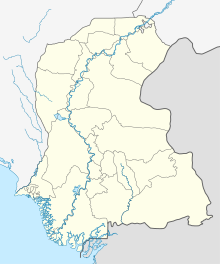Jam Salahuddin II's Second Invasion of Samanagar
| Salahuddin II's Second Samanagar Invasion | |||||||
|---|---|---|---|---|---|---|---|
| |||||||
| Belligerents | |||||||
|
| ||||||
| Commanders and leaders | |||||||
|
|
| ||||||
| Strength | |||||||
| 10,000 horsemen | Unknown | ||||||
Location within Sindh | |||||||
Jam Salahuddin II's Second Invasion of Samanagar (Sindhi: ڄام صلاح الدين ثاني جو سمانگر تي ٻيو حملو) happened in November 1521 A.D. (end of 927 A.H.),[1] the Samma dynasty of Sindh reached a critical juncture as Jam Salahuddin II, supported by Gujarati Troops, Sodhas, Jareja Sammas, Sahta Sammas, and Khangars launched a campaign against Jam Feroz. Conquest of Samanagar secured Jam Salahuddin’s dominance, with Jam Feroz's reliance on Arghun support further diminishing his credibility among Sindhis.
Background
In January–February 1521, Shah Beg Arghun moved his camp from Samanagar. Following Defeat at Battle of Fatehpur (1519), Jam Feroz came to submit, and his submission was accepted. Sindh was divided: the southern part, south of Laki, was given to Jam Feroz as Shah Beg Arghun's governor and protégé, while Northern Sindh's two sarkars Bukkur and Sehwan were annexed and placed under Shah Beg’s direct control. As a protégé, Feroz agreed to share part of the land revenue with Shah Beg Arghun. This subservience led to Feroz losing respect and prestige among his people.[2] After spending three days at Taltí, Shah Beg Arghun returned to Shál and Siwí, while Jam Feroz resumed his rule over Samanagar. However, in November 1521 A.D. (end of 927 A.H.),[1] Jam Salahuddin, took advantage of the weakening situation in Sindh and invaded Samanagar with a large army.[2]
Conquest
The Jareja Samma chief Khengar occupied Rahimki Bazar and Virawah, two critical border posts in southern Sindh.[3] This action was a direct response to Jam Feroz II’s earlier support for 'Rawal, Khengar’s adversary in Cutch. The strategic occupation was intended to block any assistance from Jam Rawal to Jam Feroz II. Along with this assistance he also provided Cutchi Troops.[4]
In Samanagar, faced with Salahuddin’s formidable forces, Jam Feroz II and his regent, Kasim Kabaka Arghun, abandoned their position and fled to Sivistan (Siwi). Jam Salahuddin’s army subsequently clashed with Daulatshah and the Nargahi Mongol tribes, who had been recruited by Jam Feroz II to bolster his defence.[5] The battle decisively favoured Salahuddin, who emerged victorious and consolidated his control over lower Sindh.
Following his victory, Salahuddin annexed the Sarkars previously under Feroz II’s control, which included:
- Chachkan Sarkar (11 Mahals): Chachkan, Jun, Fateh Bagh [2]
- Nasarpur Sarkar (7 Mahals): Nasarpur, Amarkot, Hala Kandi, Samma-vali [2]
- Chakar Hala Sarkar (8 Mahals): Chakar Hala, Ghazipur [2]
- Thatta Sarkar (18 Mahals): Thatta, Lahari Bandar, Bathoro, Bahrampur, Sakro[2]
Aftermath
This action of Jam Salahuddin II led to the Battle of Chelhar, where he and his son Jam Haibat Khan were martyred.
References
- ^ a b Abdallah Muhammad bin 'Omar al-Makki, al-Asafi Ulughkhani (1910). An Arabic history of Gujarat: Zafar Ul-Walih Bi Muzaffar Wa Alih, Vol.I. p. 138.
- ^ a b c d e f M. H. Panhwar. Chronological Dictionary of Sindh.
- ^ Williams, l.f.Rushbrook (1963). The Black Hills Kutch In History And Legend A Study In India Local Loyalties.
- ^ Gazetteer Of The Bombay Presidency, Vol V Cutch, Palanpur and Mahi Kantha 1883. 1880.
- ^ "A History of Sind, Volume II, Translated from Persian Books by Mirza Kalichbeg Fredunbeg, chpt. 14". Archived from the original on 2011-01-11. Retrieved 2008-04-28.

